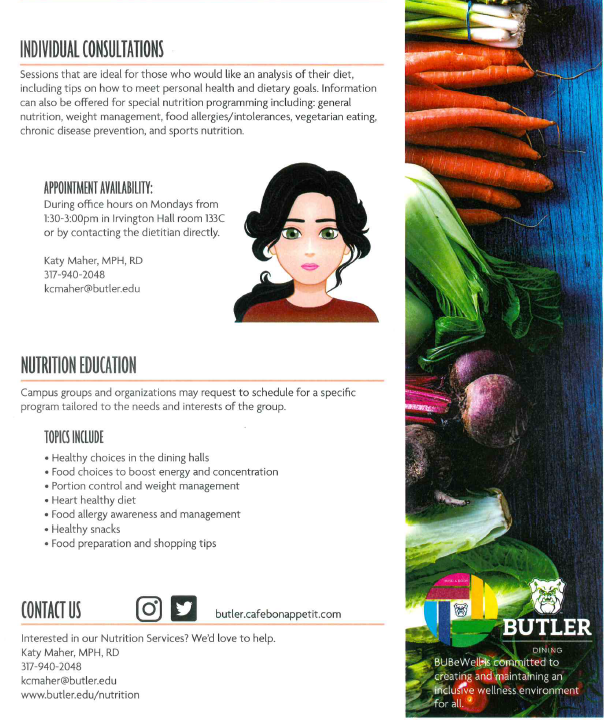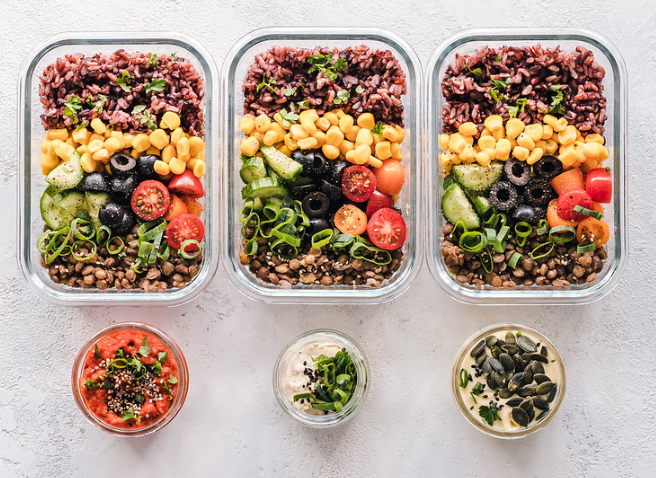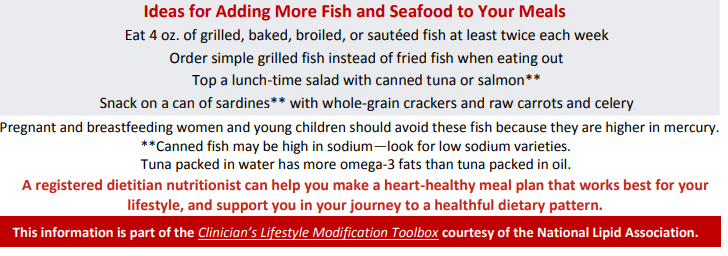Category Archives: Lighten Up Your Recipe
Dietician On-Campus Consults
Complimentary Consults for full-time faculty & staff!

Meal Prep Recommendations
Check out the blog below for great ideas on meal prep including:
- Storage ideas of prepped ingredients
- Veggie Prep
- One Pot Meals
- Use of Pre-Cooked Grains

Boost Your Health with Omega-3 Fat Finds



Turkey Tostadas
Ingredients
- 2 cup cooked turkey (cut into bite-size pieces, or 2 cups ground turkey, browned in a skillet and drained)
- 2 tablespoon taco seasoning (chili)
- 1 1/2 cup water
- 4 corn tortillas
- 1/4 cup refried beans (low-fat or fat-free)
- 1/4 cup Cheddar or Monterey Jack cheese (shredded, low-fat)
- 1/2 cup tomatoes (chopped)
- 1/2 cup lettuce (shredded)
- 2 tablespoon onion (chopped)
- 8 tablespoon taco sauce (1/2 cup)
- plain yogurt (low-fat or fat-free optional)
- guacamole (or mashed avacado optional)
Directions
1. Wash and prepare vegetables.
2. In a large skillet over medium heat, combine turkey, taco seasoning, and water.
3. Bring mixture to boil, reduce heat and simmer 5 minutes, stirring occasionally.
4. Place tortillas on a cooking sheet. Bake at 375° for 4-7 minutes or until tortillas are crispy.
5. Spread tortillas with a tablespoon of beans. Top with 1/4 meat mixture and cheese.
6. Return tortillas to oven to cook for 2-3 minutes or until cheese is melted.
7. Top with tomatoes, lettuce, onions and taco sauce. Garnish with yogurt and guacamole, if desired.
www.choosemyplate.gov/recipes/supplemental-nutrition-assistance-program-snap/turkey-tostadas
5 Foods You Thought Were Unhealthy
Food fads and facts come and go. Remember when fat-free foods were the answer to everything? It wasn’t too long before people began to learn that something else had to be added to make up for the loss of flavor caused by removing the fat. That something was sugar.
There’s nothing like a little knowledge (and a lot of sugar) for a dose of reality.
But the news is not all bad. There are some formerly “forbidden” foods you might want to reconsider.
Popcorn. After it was uncovered that a medium-sized movie popcorn along with a medium soda was like eating the nutritional equivalent of three Quarter Pounders topped with 12 pats of butter, people avoided popcorn like the plague. But recently scientists reported that popcorn contains even more healthful antioxidant substances called “polyphenols” than fruits and vegetables. These substances have been linked to a reduction in heart disease and certain cancers. More surprising is that the highest concentration of those polyphenols is contained in those annoying hulls that get stuck in between your teeth. Another plus for popcorn: It’s a great source of fiber and 100 percent whole grain.
What not to eat: Movie-theater-style popcorn. It’s cooked in lots of oil with butter and salt aplenty. Some movie theaters also pop their popcorn in coconut oil, which is about 90 percent unhealthy saturated fat. Microwave popcorn can contain twice as many calories as the more healthful air-popped variety. (Calories may not be the only problem with microwave popcorn, either, as dangerous chemicals, used in the flavorings and ink on microwave bags, could be toxic.)
Chocolate. It used to be associated with things like calories, acne, sugar and caffeine. But dark chocolate gets a pass, because it has so many healthy benefits (sorry milk chocolate fans). It contains powerful antioxidants called flavonoids, which are also abundant in red wine, green tea, fruits and veggies and are associated with a decreased risk of coronary heart disease, cancer, high blood pressure and stroke.
What not to eat: A big slab of chocolate cake or a daily bar of chocolate. Dark chocolate still has calories, after all, which can lead to weight gain (and weight gain increases your risk for heart problems and strokes). The German study that found chocolate’s health benefits also found you need only consume about six grams a day, which is the equivalent of about one square of a chocolate bar.
Eggs. If you had high cholesterol or heart disease—and even if you didn’t—you were once warned to limit your consumption of eggs. New research has found that healthy adults can consume an egg a day without worrying about increasing their risk of heart disease. According to the American Heart Association, the lutein found in eggs can actually be protective against the progress of early heart disease. Eggs are also loaded with protein, Vitamin D and valuable vision and brain-fostering vitamins and minerals.
What not to eat: A four-egg omelet cooked in lots of butter and oil, stuffed with cheese and sausage. That’s hardly an excuse to indulge in “healthy” eggs; neither is an order of fried eggs—even if you do order whole-wheat toast on the side. (If you fry an egg at home in a nonstick pan with no added fat, it’s OK.)
Coffee. Stunted growth … spikes in heart disease … cancer. True or false? That’s old news. The new scoop on coffee is that its health benefits far outweigh its risks. Recent studies have found that coffee contains high levels of antioxidants and may protect against Parkinson’s disease, dementia and type 2 diabetes.
What not to drink: Lots of it. Heavy caffeine use—anywhere from four to seven cups a day—can create its own set of problems, like anxiety, irritability and sleeplessness. So can all the trimmings, like half -and-half and sugar, adding anywhere from 40 to 70 calories per cup (and up).
Peanut butter. Although a two-tablespoon serving can pack about 15 grams of fat, that fat is the heart-healthy, monosaturated kind (like olive oil). Peanut butter also helps with appetite regulation, since it’s packed with fiber and protein. It also contains health-enhancing vitamin E, potassium and vitamin B6. And research shows that consuming peanuts can decrease your risk of diabetes, heart disease and other chronic health conditions.
What not to eat: Just any peanut butter—it’s not all created equal. Watch the sodium counts, which can range from 40 to 250 milligrams per tablespoon serving. Sugar, too, can be an issue, and is more prevalent in the reduced-fat varieties.
www.healthywomen.org/content/blog-entry/5-foods-you-thought-were-unhealthy%E2%80%94-arent
Smoothie Substitutes/Additions
- Mango.
- Papaya.
- Pear.
- Chia seeds.
- Fresh dates.
- Nut Butters.
- Unsweetened applesauce.
- Avocado (won’t add the sweetness, but will definitely add the thick and creamy texture)
Before you fire up the blender, consider these nutritious additions
Smoothies can serve as a cool, creamy, delicious meal-in-a-glass. But when you whip up your favorite smoothie, is it going to nourish you or merely satisfy your taste buds? And what will it do to that number on the scale? Here are six ingredients our dietitians believe will help you create the most nutritious, filling smoothies ever:
1. Dark, leafy greens
Spinach and kale are great staples for smoothies. But don’t be afraid to branch out and try beet roots, celery (with leaves) or other dark, leafy greens.
Greens are low in sugars and calories, and provide more iron and protein than fruit. They’re also bursting with fiber, folate, and phytonutrients like carotenoids, saponins and flavonoids.
“A smoothie that is all fruit is an unbalanced mini-meal,” says Anna Taylor, MS, RD, LD. “Grab a big handful of greens, rinse, and add to your smoothie to ensure you’re not missing out on key nutrients.”
All veggies help support a healthy weight, keep bowel movements regular, fight inflammation and decrease the risk of chronic disease. But research shows the vast majority of Americans struggle to eat the recommended three to five servings a day.
“If you have a difficult time eating vegetables, smoothies are a great way to increase your intake. Add as many dark, leafy greens as you like!” says April Verdi, RD, LD.
2. Cruciferous veggies
Shredded cabbage, bok choy (and leafy green kale, as well) are part of the special cruciferous family of vegetables.
“Cruciferous vegetables are my favorite ingredients to add to a smoothie. These nutrient-rich gems contain glucosinolates, an anti-inflammatory phytonutrient,” says Brigid Titgemeier, MS, RDN, LD.
Researchers are exploring cruciferous vegetables because studies have linked glucosinolates to a lower risk of certain cancers. And one study linked broccoli intake to increased survival in bladder cancer.
Whatever vegetable you choose, “smoothies are an incredibly easy vehicle for increasing your overall consumption, because you can’t taste the veggies!” she says.
3. Nuts, nut butters and seeds
Veggies are vital in a smoothie, but protein will stabilize your blood sugars and keep you feeling full.
Peanut butter, other nut butters, nuts and seeds provide protein — and they also provide heart-healthy fat.
“Most smoothies provide carbohydrate and protein but lack fat,” notes Kate Patton, MEd, RD, CSSD, LD. “The extra bit of fat in nuts, nut butters and seeds helps to slow your digestion.”
Choose natural peanut or almond butter (all peanuts or almonds, no fillers), or add walnut halves to boost your omega-3 intake.
Ground flaxseed is another great option. “It’s a source of omega-3 fat and provides extra protein and fiber,” says Ms. Patton. Two tablespoons contain 60 calories, 4.5 grams of unsaturated fat, 3 grams of protein and 4 grams of fiber.
“Because extra fiber also helps with bowel regularity, you may want to start with a small serving of flaxseed. Then increase, as desired, up to 2 tablespoons per day,” she notes.
Because nuts, seeds and nut butters are high in calories, “be mindful of portion sizes,” cautions Ms. Verdi. “Add no more than half an ounce of nuts or seeds, or 1 tablespoon of nut butter, per serving.” For example, eight walnut halves equal half an ounce.
4. Greek yogurt and milk/ milk alternatives
Dairy products are another source of protein, which can help make your smoothie a true meal replacement that keeps you satisfied.
“Plain Greek yogurt and tofu are nice alternatives to protein powders, which often come with added flavors and sugars that you may not want or need,” says Dawn Noe, RD, LD, CDE.
Ms. Verdi recommends nonfat, plain Greek Yogurt. If you want to add liquid to your smoothie, she suggests using unflavored skim or 1 percent cow’s milk, or unflavored almond or soy milk.
5. Berries
Love fruit in your smoothie? Then berries are the way to go.
“Raspberries, blueberries, strawberries and other berries add a sweet and tart flavor, and their fiber helps you stay full,” says Ms. Noe.
“Berries also contain antioxidants, which research suggests may have cancer-fighting properties. And because they’re low on the glycemic index, berries won’t spike your blood sugars as quickly as other fruits do.”
Try tossing a mixture of berries into a smoothie. It’s easy to find frozen bags of mixed berries at the grocery store. “Just be sure to buy the plain fruit mixture – without added sugar,” she adds.
Frozen fruit is a nutritious replacement for ice in your smoothies, too.
Now that you’re armed with a list of the best ingredients to add to a smoothie, you should be able to create nutrient-packed, quick meals that also make your taste buds happy.
health.clevelandclinic.org/the-top-6-ingredients-to-add-to-your-smoothie/
Strawberry Pineapple Kale Smoothie
A Healthier Fall Treat
Butternut Squash and Apple Muffins with Pumpkin Seed Streusel

Muffins:
1 1/2 cups of cooked butternut squash (I like to halve mine, scoop out seeds, and slow roast for about an hour at 325 degrees Fahrenheit)
4 eggs
1/4 cup of dark brown sugar (up to 3/4 cup for a sweeter muffin)
1/3 cup applesauce
6 T vegetable oil
1 t salt
1 t baking soda
2 t baking powder
2 t cinnamon
2 cups whole wheat pastry flour
1 medium apple, peeled, seeded, and finely chopped
Streusel:
1/4 cup dark brown sugar (can use more here too if you like)
1 t cinnamon
1/3 cup chopped and toasted pumpkin seeds
Directions
1. Preheat oven to 350 degrees Fahrenheit.
2. In a large bowl, mix wet ingredients by whisking together cooked squash, eggs, dark brown sugar, applesauce, and vegetable oil.
3. In a medium bowl, mix dry ingredients by combining salt, baking soda, baking powder, cinnamon, and whole wheat pastry flour.
4. Add dry ingredients to wet ingredients and whisk until just combined. Stir in chopped apples. Spoon into greased muffin tins about 2/3 of the way full. (You can use cupcake papers if you like.)
5. Combine streusel ingredients (brown sugar, cinnamon, and pumpkin seeds) and sprinkle a nice spoonful over top of each muffin before baking.
6. Bake muffins for about 15 minutes until just done and a tester comes out basically clean. Let cool a few minutes in tins and then remove muffins to a cooling rack. (I had to use a knife to loosen them before removing.)
Tofu with Brocolli

Tofu cooked until golden brown, and broccoli sautéed in a soy and scallion sauce make up this one-skillet meal. Serve with a side of brown rice for a quick dish.
Ingredients
Directions
1. Put the tofu on a cutting board and cut it in half and then cut each half into 4 equal pieces.
2. Put 2 layers of paper towel on a cutting board and put the tofu on top. Let drain at least 20 minutes (and up to 2 hours).
3. Place a skillet over medium heat and when hot, add 2 teaspoons oil. Add the tofu, one piece at a time, and cook until golden, about 3 minutes per side. Remove the tofu to a plate and set aside.
4. Reheat the skillet and when it is hot, add remaining 2 teaspoons oil. Add garlic and scallions and cook until just golden, about 2 minutes. Add the broccoli and water and raise the heat to high. Cook until the broccoli is tender, about 4 minutes.
5. Return the tofu to the pan and add the remaining ingredients. Stir well.
6. Serve with a side of brown rice.



